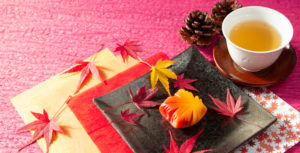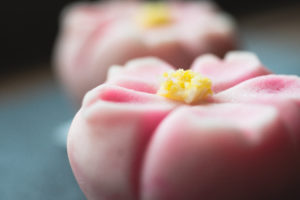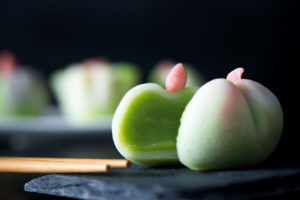
In December 2013, “Washoku/traditional Japanese food culture” was registered to be included in the UNESCO Intangible Cultural Heritage. Washoku immediately became very popular worldwide after this distinction. What makes Washoku unique is that it expresses the changes in seasons. This is also the case for Wagashi or Japanese sweets, they express the exquisite skills of Japanese confectionery chefs.
Wagashi can be divided into three broad categories (depending on the water content): Namagashi, Han-namagashi, and Higashi. Nerikiri can be categorized as “Namagashi,” which contains the most amount of water. It is a famous crafted confectionery that is highly artistic, called “Jo-Namagashi.” In Japan, they are given during celebrations or served when welcoming guests. They are also served as sweets to match exceptionally dark, opaque matcha tea in tea ceremonies.

The name “Nerikiri” (kneading and cutting) is derived from the dough-making process where you knead the dough very well. It is an artistic Wagashi that incorporates seasonal characteristics and sceneries delicately. Generally, there are no rules in terms of its design. However, popular designs include sakura in spring, river surfaces, fish like freshwater trout and goldfish in summer, autumn leaves and chestnuts in the fall, and snow scenes in winter. The plants, animals, and seasonal sceneries are expressed using vibrant colors.

The many types of intricate designs of Nerikiri are completed using a triangular wooden stick called “sankaku-bera”, which makes various patterns using the triangle or using a special pair of scissors. When you slowly press the stick against Nerikiri, it creates lines with slight variations in depth, flower petals, and water surfaces. The scissors are used to make three-dimensional shapes, such as making petals from a chrysanthemum to stand up. You can observe advanced craftsmanship in these exquisite shape-making as well.
Much like the old times, the Japanese enjoy eating seasonal food to feel the coming and changing of seasons. You can call it a way of life for a country like Japan, where all four seasons come to pass. Nerikiri are made to match each season, and they are pieces of art that you can enjoy in terms of taste and appearance. Stores and chefs have different tastes, so it would be fun to visit as many different stores as possible.
Explore your favorite Japan!
-------------------------------------------------------------------------
[Reference]